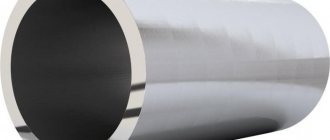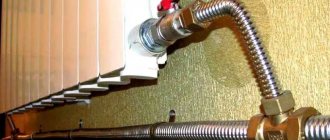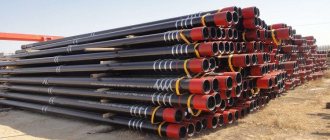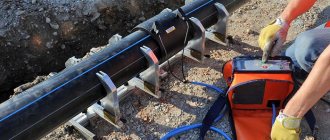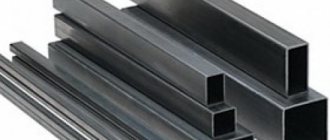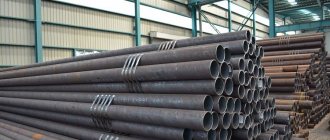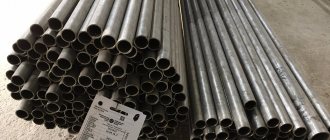Decorative pipes are products that are used for decoration indoors and outdoors. The internal part of such a product is no different from a regular pipe, however, the outer wall has a varied (depending on the specific case) relief. Today, the range of decorative twisted pipes of various shapes and sizes is incredibly wide.
Twisted decorative pipe is the basis of a wide variety of designs and structures
What are decorative twisted pipes used for?
The main difference from standard hollow parts is their appearance, which is aesthetically pleasing. That is why they are used to decorate the interior of rooms, as well as in the production of various designs. These custom products can be used in the same conditions as conventional pipes, and in some cases they are more efficient.
Such products are extremely popular in the construction industry, where various frame structures are made from them. Such designs not only look much more presentable, but are also in no way inferior to conventional pipes in terms of technical characteristics. Let's consider the main structures and elements in which decorative twisted pipes are used:
- Decorative parts are often used to make stands for gazebos;
- various non-standard fences;
- Twisted products are very popular when installing grilles on windows;
- In addition, such parts are very popular in the furniture industry.
The twisted pipe can be used as a support in load-bearing structures
Twisted decorative pipes are used everywhere and the demand for them is growing every year. Thanks to this, products that are new in form and complexity appear.
Twisted pipe: production and scope
Currently, there is simply a huge number of different products that are made from pipes. They may have a different appearance, purpose, and even material from each other. At the same time, the twisted pipe occupies a separate niche in this area, since it involves an almost complete change in the original workpiece.
Amateur photo of similar products without coating
To begin with, it is necessary to say that such structures are made from products with thin walls. At the same time, a twisted pipe is characterized not by the method of creation, but by its appearance. Therefore, for the work you will need completely ordinary material and appropriate equipment.
A finished gazebo created using products of this type
Manufacturing
First of all, it must be said that there are several different ways to create these types of products, and they all depend on the availability of appropriate equipment.
Therefore, if you create a twisted pipe with your own hands, then you need to select all the necessary devices in advance and decide on the most convenient method.
These materials can have different shapes and structures
- In fact, the principle of creating such materials is to apply a kind of screw notch on the workpiece . Moreover, this procedure can be performed both cold and using special methods of heating the pipes to soften the base.
A special machine for creating such a notch
- Creating a machine for making a twisted pipe with your own hands is quite simple, but you need to take into account certain parameters and functions . At the same time, most experts are inclined to use a special broach, which has three or more rolling shafts that deform the workpiece in certain places if it is fed under rotation.
Another type of such equipment with automatic feeding
- Other craftsmen use a special workbench, on which the pipe itself is attached . After that, the manufacturing instructions require heating the workpiece, and then using forging hammers of a certain shape, apply the appropriate notch.
Tip! To make different shapes of coils, additional nozzles or inserts are usually used.
Their appearance depends only on the personal preferences of the master, based on the desire to achieve a certain appearance.
Making a similar structure using the forging method
Application area
Usually a twisted decorative pipe is created, rather than a bizarrely shaped supporting structure. The fact is that after such treatments, the technical characteristics of the material change greatly, and it can only be used as decoration.
To improve the appearance and protect against corrosion, all such structures must be torn with special compounds
It is worth noting that to obtain a better appearance, a layer of various materials is applied to the finished product. Their choice depends on the desire to achieve a certain effect or choose a specific interior. However, the price of some such dyes or enamels is quite high and causes additional costs.
Some types of structures using these pipes are real works of art and are very expensive
If the product is created by forging, it is usually blued, and gold or silver pipe paint is applied to certain areas. Chrome or nickel coating also looks good on such materials, but such work is very expensive.
Advice! Sometimes it is much easier to purchase such a factory-made design than to create it yourself.
This will help save money and time.
The quality of such products is determined by the depth of the notches and their uniformity, which also affects the cost of the final product.
Recommendations from the experts
- If you are making a twisted pipe with your own hands, then it is better to first test the existing equipment on a small piece of cutting, and only after achieving the desired result can you begin to work. This will allow you to determine the optimal parameters and modes.
Some versions of such elements are created exclusively by hand and used for the manufacture of decorative structures
- The thinner the wall of the pipe, the easier it will be to work with. However, when forging, you can use almost any available product.
- Before starting to apply notches, experts recommend creating markings. This way you can not only get an idea of the final appearance, but also simplify the rest of the process.
If a decision has been made to use such material to support weight, then it is worth inserting a pipe of a smaller diameter inside so that the loads on them are distributed evenly
Conclusion
By studying the video in this article, you can become more familiar with these types of materials and methods of their manufacture. At the same time, taking as a basis the text given above, it is worth concluding that this work may require certain skills, especially if the product is created by forging.
It should also be noted that the twisted pipe should not be used as a supporting structure. Lines of tension are created in it, and the strength of this material drops significantly.
Source: https://gidroguru.com/trubi/truby/526-vitaya-truba
Features of the production of decorative twisted pipes in industry
The production of such decorative products is not particularly difficult. In order to make such a part, you need a regular pipe, usually with thin walls. The most popular are those products that are made seamlessly, however, electric-welded parts are also suitable for creating a decorative relief pipe.
To produce decorative twisted pipes, the workpiece is processed on a special rolling mill. The hollow part passes through rolling rollers, resulting in the formation of a certain relief. The position of the rollers is adjusted depending on the diameter of the pipe.
Helpful information! Rolling equipment for making decorative twisted products includes three rollers located on a support. It is worth noting that each rolled part is usually equipped with an individual wire.
It is possible to adjust the support, which is used to strengthen the cutter. This allows you to process products with different cross-sectional parameters and control the angle of inclination of the cutting itself.
First of all, before starting the work process itself, it is necessary to set the necessary settings and adjust the elements of the machine so that you can install the workpiece of the required diameter.
After the above steps, the calipers are brought together and secured using the adjusting screw in the desired position. After this, you can begin the process of manufacturing the relief part. It is also worth noting that the notch can be of two types:
- straight;
- screw.
Decorative steel pipes do not look as impressive as products made from non-ferrous metals, but their cost is lower
There are no restrictions on length or material as such. Embossed decorative pipes are made from both ordinary steel and non-ferrous metals. The most impressive look are structures made from decorative products made of non-ferrous metals, however, the cost of such products is higher than steel ones.
Rolling machine: operating principle
The operating principle of such a machine is called rolling: the rollers cut the top layer of the pipe, without cutting the entire metal completely.
Passing through the rollers, the pipe is deformed and acquires a characteristic relief. Depending on the diameter of the pipe, the position of the rollers can be adjusted. Before starting work, preparatory adjustments are made in accordance with the thickness of the material. The roller angle is set to one of the popular positions - 35, 45, 55 or 90 degrees. The productivity of such a machine is up to 120 m/h, varying slightly depending on the model and manufacturer. If you have a machine, you can make a twisted pipe with your own hands very quickly and simply.
Do-it-yourself machine for the production of decorative pipes
Not every owner can afford to purchase such an expensive product as a twisted (embossed) decorative pipe, however, if desired, this product can be made with one’s own hands. To do this, you will need to assemble a homemade machine, on which the work of obtaining decorative parts will be carried out.
Experts do not recommend doing this to those who do not understand machines and their structure at all. And for those who at least approximately understand the essence of the issue, this instruction may be useful.
Let's consider the main stages of assembling a machine for producing rolled metal with a pattern on the outer wall:
- First of all, it is necessary to make a special device that will serve as a support for working on a lathe (rest). To do this, you need to place three rollers in a certain position.
- Then you need to make guide elements for the steady rest. This will allow the support element to slide over them.
- The electronic part of the equipment must have a motor and a chain drive. The working process itself is quite simple: a round pipe is fixed in the chuck, after which it is necessary to engage the gear.
- Next, it is necessary to bring the supporting part in such a way that the rollers fix the pipe and the steady begins to slide along the previously installed guide elements.
You can assemble a machine for the production of twisted pipes with your own hands, but if you plan a large amount of work, it is better to buy a ready-made one
This machine is perfect for occasional or even one-time use, however, it is not suitable for the production of twisted decorative pipes on an industrial scale. Industrial machines have many advantages compared to home-made ones: the ability to adjust the angle of inclination, the variability of processed diameters from 10 to 150 mm, as well as high productivity due to speed (120 km/h).
Artistic metal products
Forged products for stairs and gazebos, fences, doors and windows, various decor and decorations are beyond competition when compared with any other type of “structural” decor. But to produce a sufficiently large volume of forging by hand requires a lot of time and effort. Using art rental is convenient and profitable, due to the simplification of forging work. You can create unique creations based on a decorative pipe, strip or “forged” square. In addition, complex patterns on metal are extremely difficult to produce using hand forging methods, and here artistic metal rolling becomes an excellent help.
Patterns in the form of climbing plants, Greek and Gothic motifs, geometric and fantasy - in the offers of modern rental manufacturers you can find everything you need for the base.
Stairs and gazebos, home and landscape decor using forged products acquire the most important aesthetic and performance qualities: strength, beauty and style, reliability and durability, as well as complete uniqueness.
Types and characteristics of decorative profile pipes
Decorative profile pipe is one of the types of rolled metal, which differs from ordinary pipes in that it has a non-standard cross-sectional shape. In addition, the internal diameter of such products is changed, so they are ideal for making fences, as well as for forming frames of various structures. The range of profile decorative pipes is quite wide.
Helpful information! To make various fences, as a rule, pipes with a wall thickness of 3 mm are used.
However, there are also thin-walled products with a wall thickness of 1.5 to 3 mm. Such profile decorative parts are used, as a rule, in the furniture industry. Parts with a wall thickness of up to 4 mm are considered medium and are used for supports in fences, as well as running parts of various mechanisms. Profile relief pipes can also be thick-walled, with a wall thickness of up to 8 mm. The frames of buildings and massive machine tools are made from such products.
The most popular forms of profile parts with textured edges are:
- rectangular;
- square.
The length of such products can be from 6 to 12 meters. The design on the part is usually selected individually for a specific case. The cost of decorative profile pipes depends on the volume of products purchased.
Profile pipes with a relief surface are also popular
Products – Tekhmashholding – group of companies, official website
- Quite often, twisted pipes can be found in various fields of application. What are they for, what is the process of making them? These products are used mainly for decorative purposes.
Moreover, they do not always perform the function of a specific conductor of any liquid.
Let's take a closer look at the scope of application of pipes, as well as the features of their production, the ability to do the work yourself, and what the homemade material will look like, and whether it is worth spending additional effort and money on making a machine.
Manufacturing of the machine
To make a twisted pipe machine with your own hands, you need some engineering and technical knowledge. The main thing in do-it-yourself production will be the correct drawing up of drawings. Only correctly calculated and executed drawings will provide all the necessary parameters for the production of precision equipment.
However, if there is no time, energy and special need for serious brainstorming, it is quite possible to buy this machine. Despite its considerable cost, it pays for itself fairly quickly.
Although, naturally, it would be more practical to take it as an addition to an existing production line, and not as an independent device.
How to make a decorative twisted pipe for railings, racks, posts -Publications
A twisted metal pipe is a special element among metal structures, which is manufactured by cold drawing through special rollers.
Twisted pipe is a decoratively designed metal pipe, the walls of which are up to 4 mm thick, which can be used to make poles, gazebos, lanterns, and handrails. A twisted pipe can be used as a separate decorative element or in combination with other natural materials (wood, brick, stone).
Staircase and gate posts, window grilles and various railings, handrails, elements of forged vintage furniture - these are just some of the items that can be made using twisted pipe.
The versatility of the element allows you to achieve the charm and uniqueness of the finished products, which is loved by connoisseurs of the beauty of the interior of a home, garden, and landscape.
To make a twisted pipe, a round seamless or electric-welded thin-walled pipe is used, both from ordinary steel and stainless steel, of almost unlimited length.
On the rolling machine, adjustments are made, the angle of the cut being formed, and the position of the rolling rollers are set, corresponding to the diameter of the rolled pipe.
The cut pattern is applied to the surface when the workpiece is drawn through rolling rollers.
Decor-4 - a universal machine for the production of twisted pipes
We have developed a Decor-4 machine for the production of various twisted pipes.
You can find out the price and equipment here.
The rolling unit is equipped with three rollers. Each rolling roller is equipped with its own drive and is mounted on an adjustable slider (support), which allows you to change the diameter of the rolled pipe and the angle of inclination of the cut being formed.
Before starting work, the operator adjusts the angular position of the rollers to form a cut at the required angle of inclination, loosens the fixing screws of the sliders (calipers) and moves them apart using the adjusting screw to ensure installation of the rolled pipe. After installing the workpiece, the sliders (calipers) are brought together and their position is fixed with screws.
The machine is ready for cutting and the drive of the rolling mechanisms can be turned on. This is how straight and helical triple cuts are applied.
| production of twisted pipes at Decor-4 |
If it is necessary to perform a gear cut or a screw crosswise, then such processing is carried out in two passes. On the first pass, the first three cuts are formed, then the angular position of the rollers is reconfigured (if necessary to obtain the required pattern), then the second pass is made and the remaining three cuts are formed.
Decor-4 is produced using advanced high-precision imported equipment, and our confidence in the capabilities and quality of our products is expressed in the duration of the warranty period - 3 years.
Due to the ability to adjust the angular position of the rolling rollers relative to the rolled workpiece, it is possible to obtain various types of twisted pipe:
| straight cut pipe (turn angle 0 degrees) | twisted pipe (set coil angle 30; 45; 60 degrees, one pass) | cross-cut pipe (set coil angle: 30; 45; 60 degrees, two passes) |
The variety of options can be further expanded by applying additional coatings of different colors and textures both to the entire pipe and to individual elements of the screw pattern.
stanki-d.ru
Advantages of embossed profile pipes
Like any other product, decorative profile rolled products have their own advantages that are worth paying attention to:
- Such products are quite durable and have a long service life. If you use a decorative profile part for arranging a fence, it is recommended to correctly design the future structure;
- the use of a relief profile allows it to be used in combination with other materials (for example, with a brick fence support);
- in addition, the relief profile can be adjusted to any span, having previously measured and prepared it;
- good transparency of the relief profile ensures a presentable appearance of the area from the inside, as well as from the outside. Thanks to this, the various plants growing on the site are not shaded;
- One of the main advantages of decorative profiles is the wide selection of products. If desired, everyone can choose something suitable to their taste;
Important! Experts recommend periodically applying an anti-corrosion coating to decorative profile products used to construct the fence. If the anti-corrosion coating is updated, the service life of such a fence will increase several times.
- Another advantage of such products is their high strength characteristics in comparison with a conventional round pipe of the same thickness and with the same cross-sectional parameters.
The above advantages allow decorative profile pipes to occupy a confident position in the modern building materials market.

